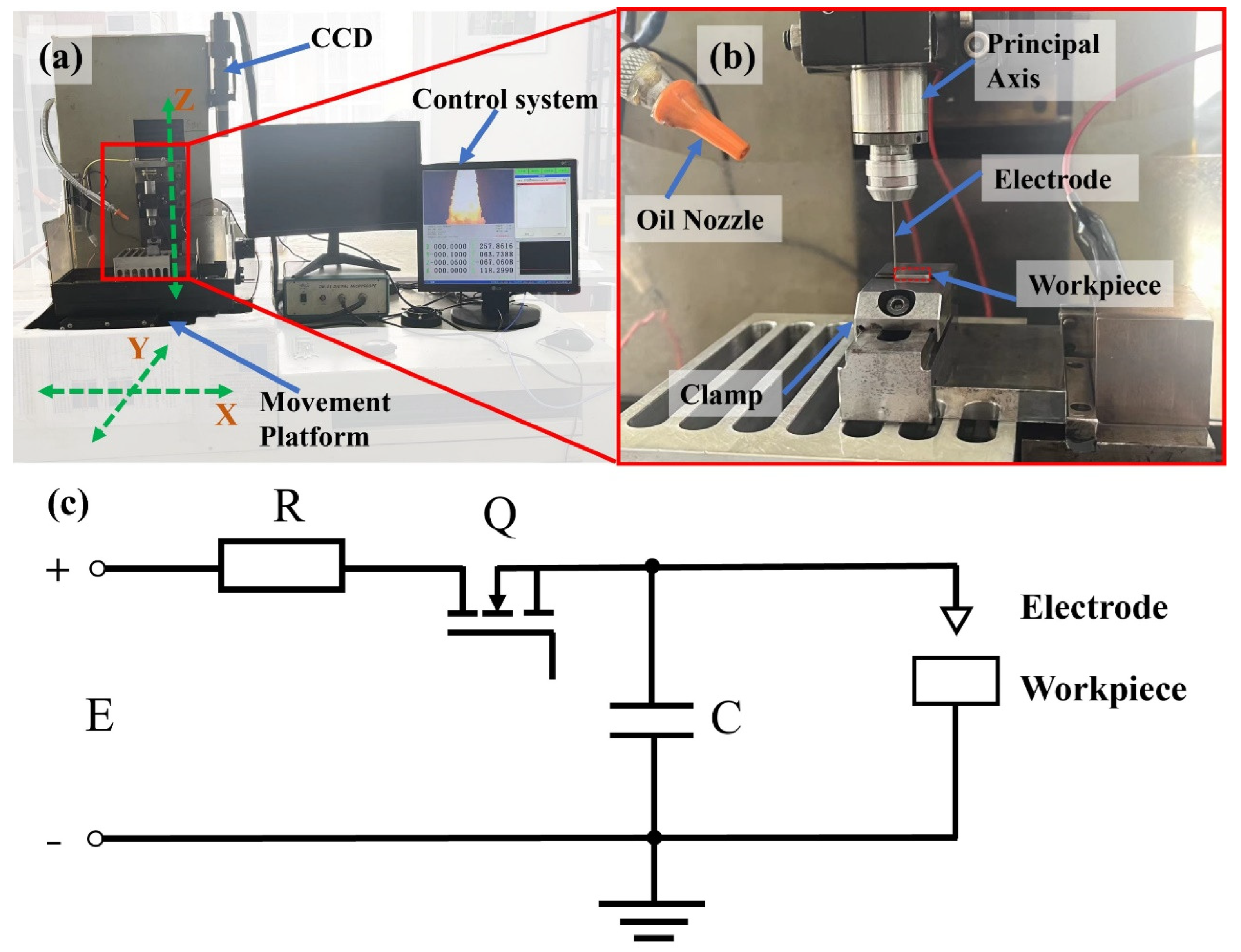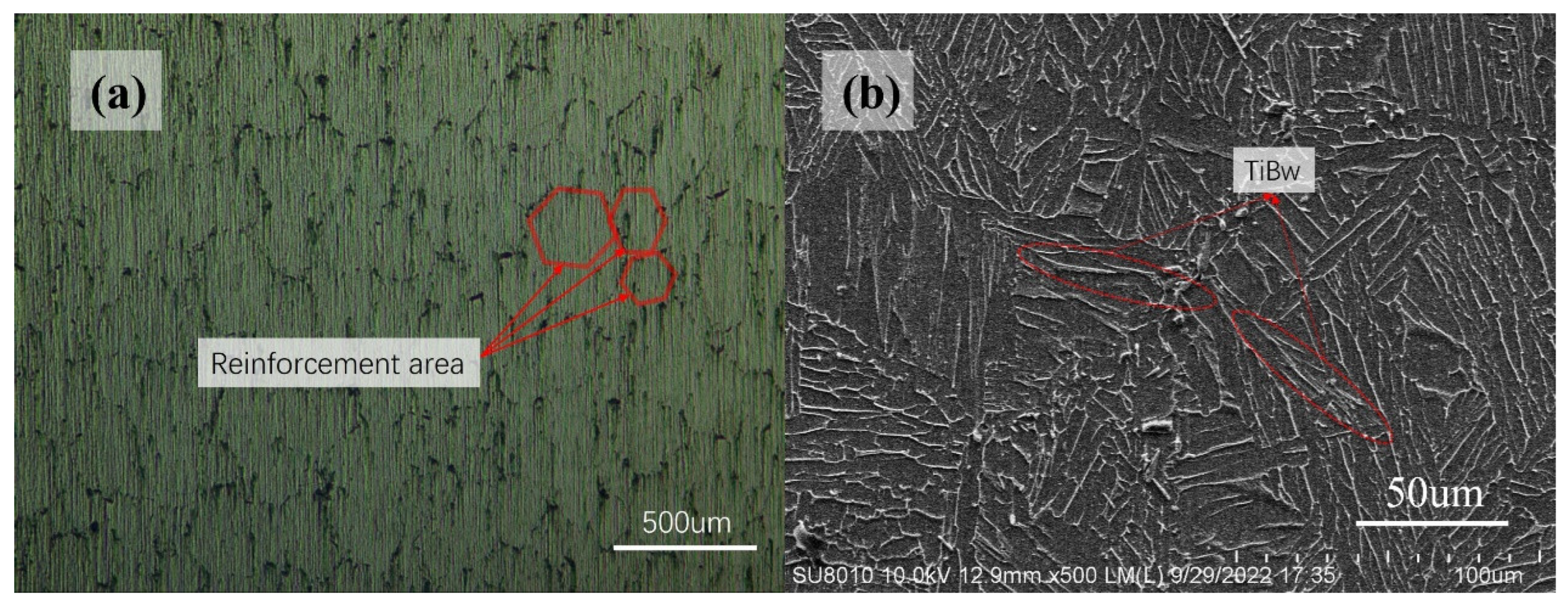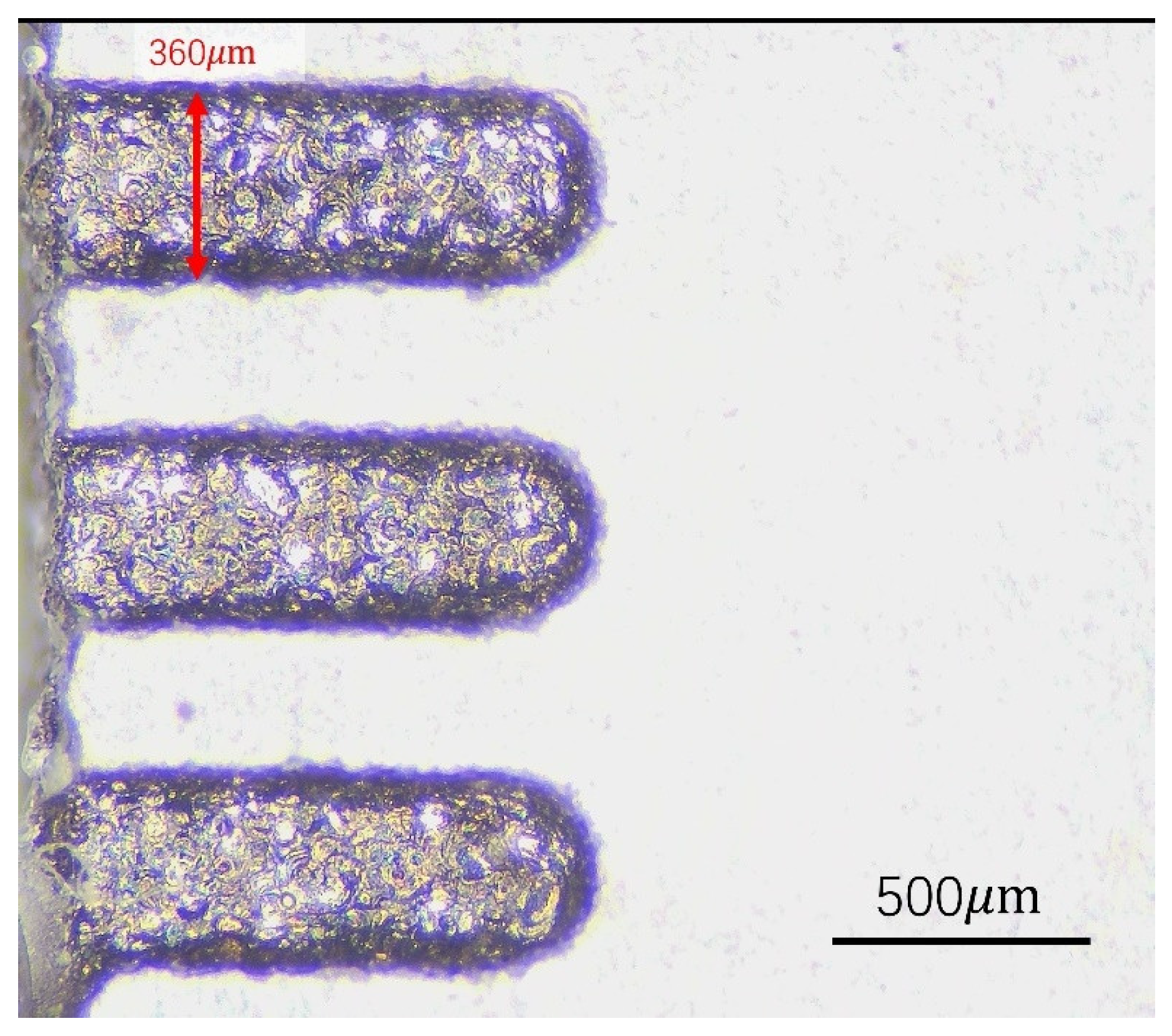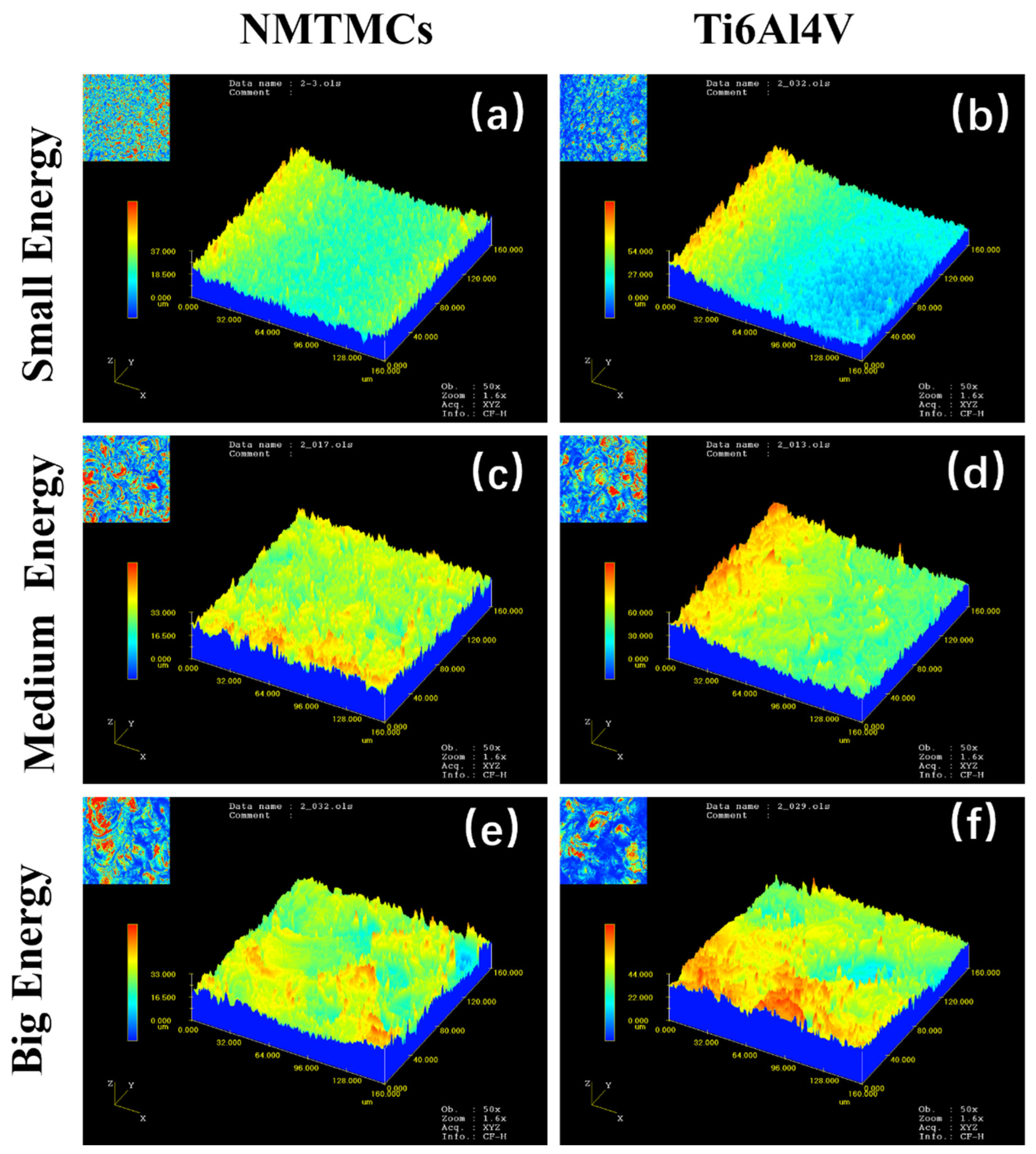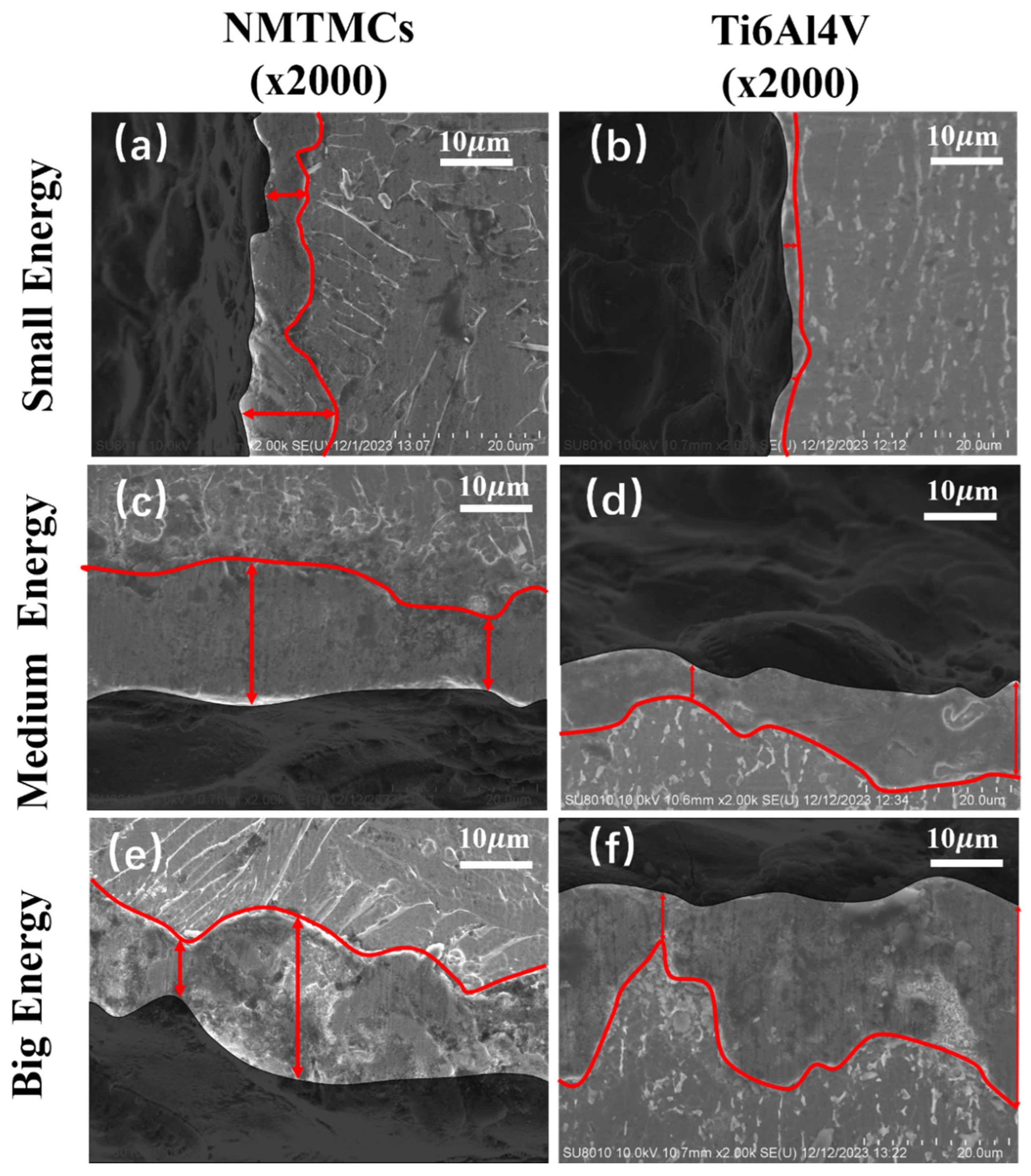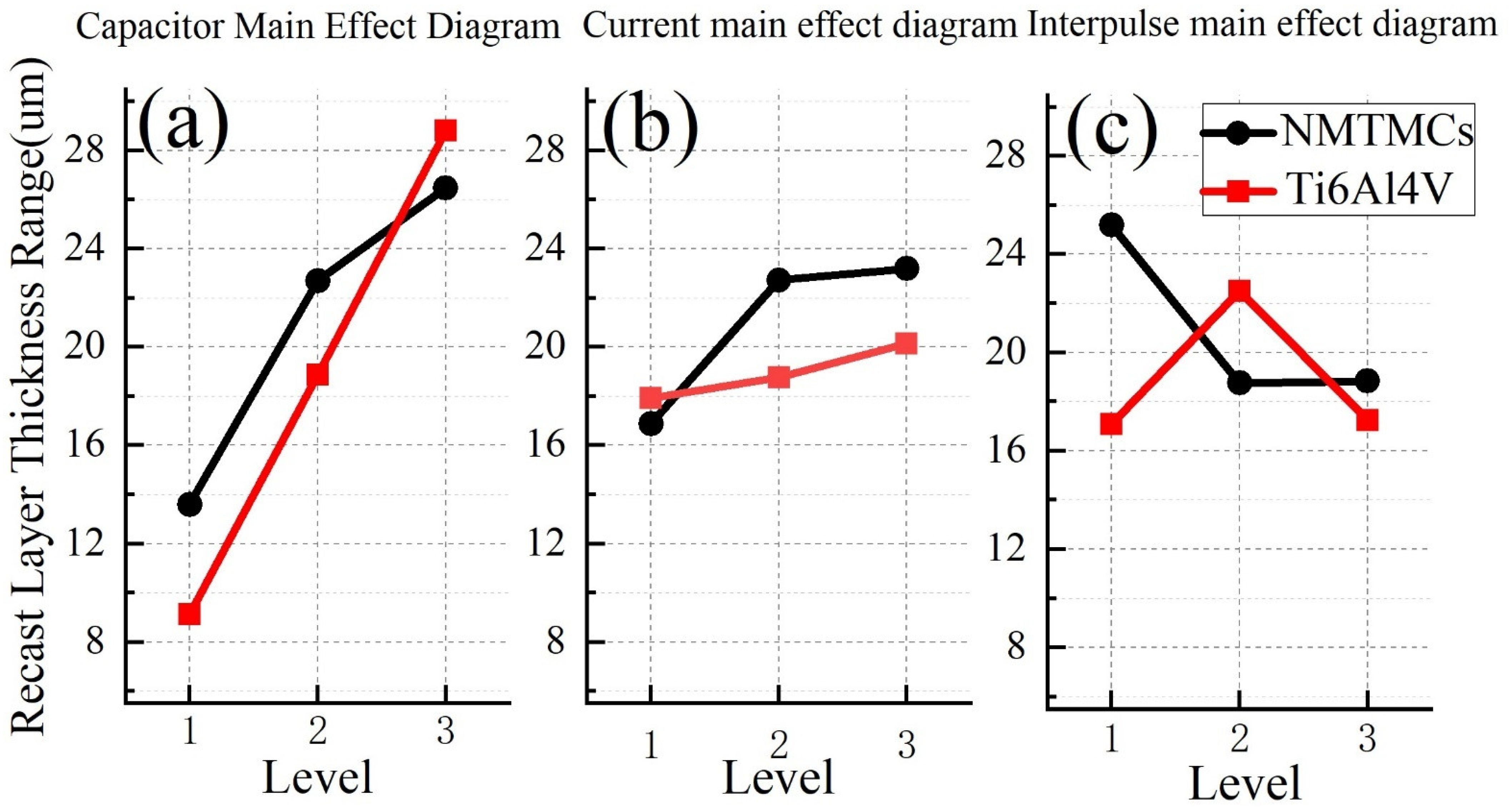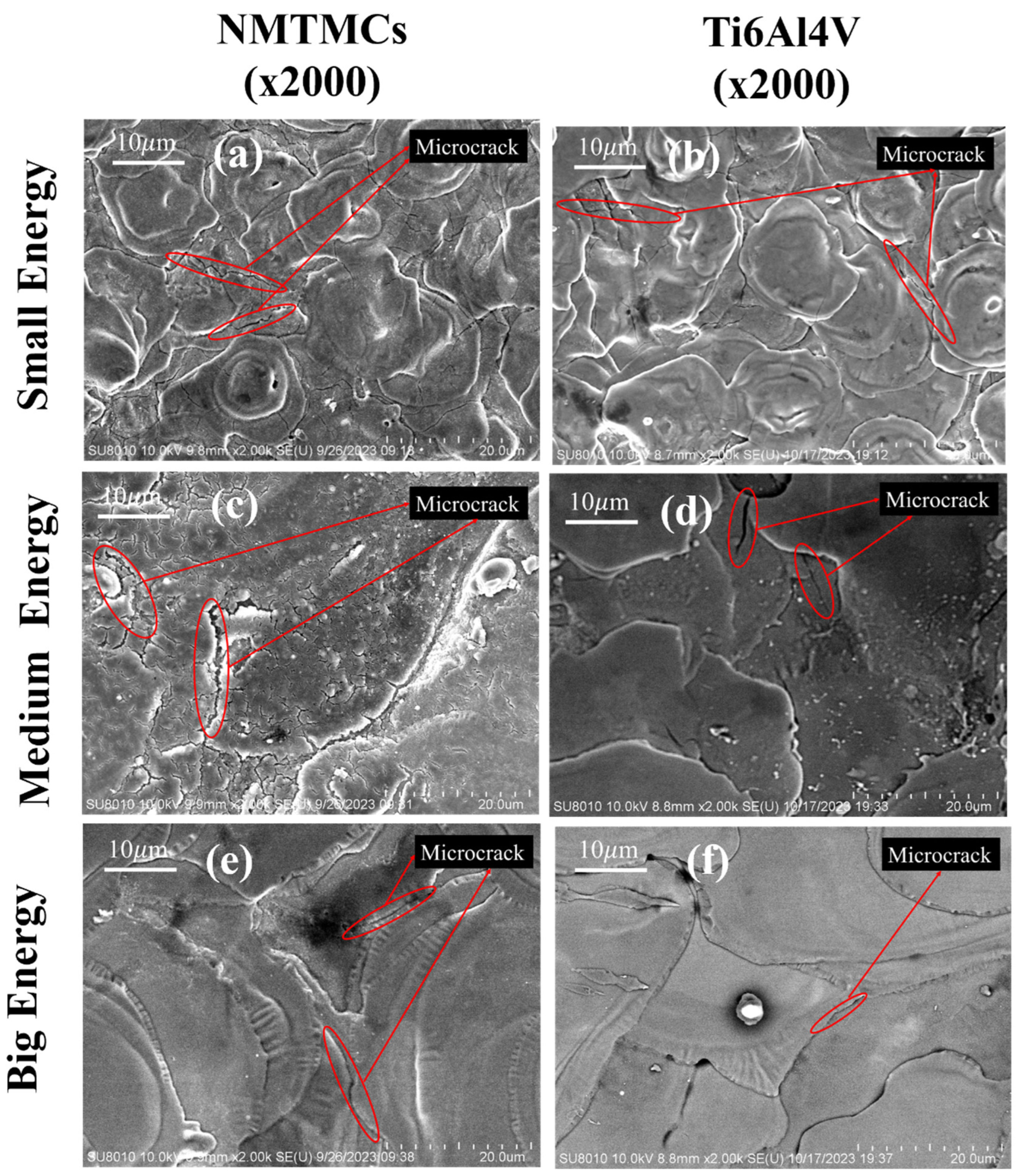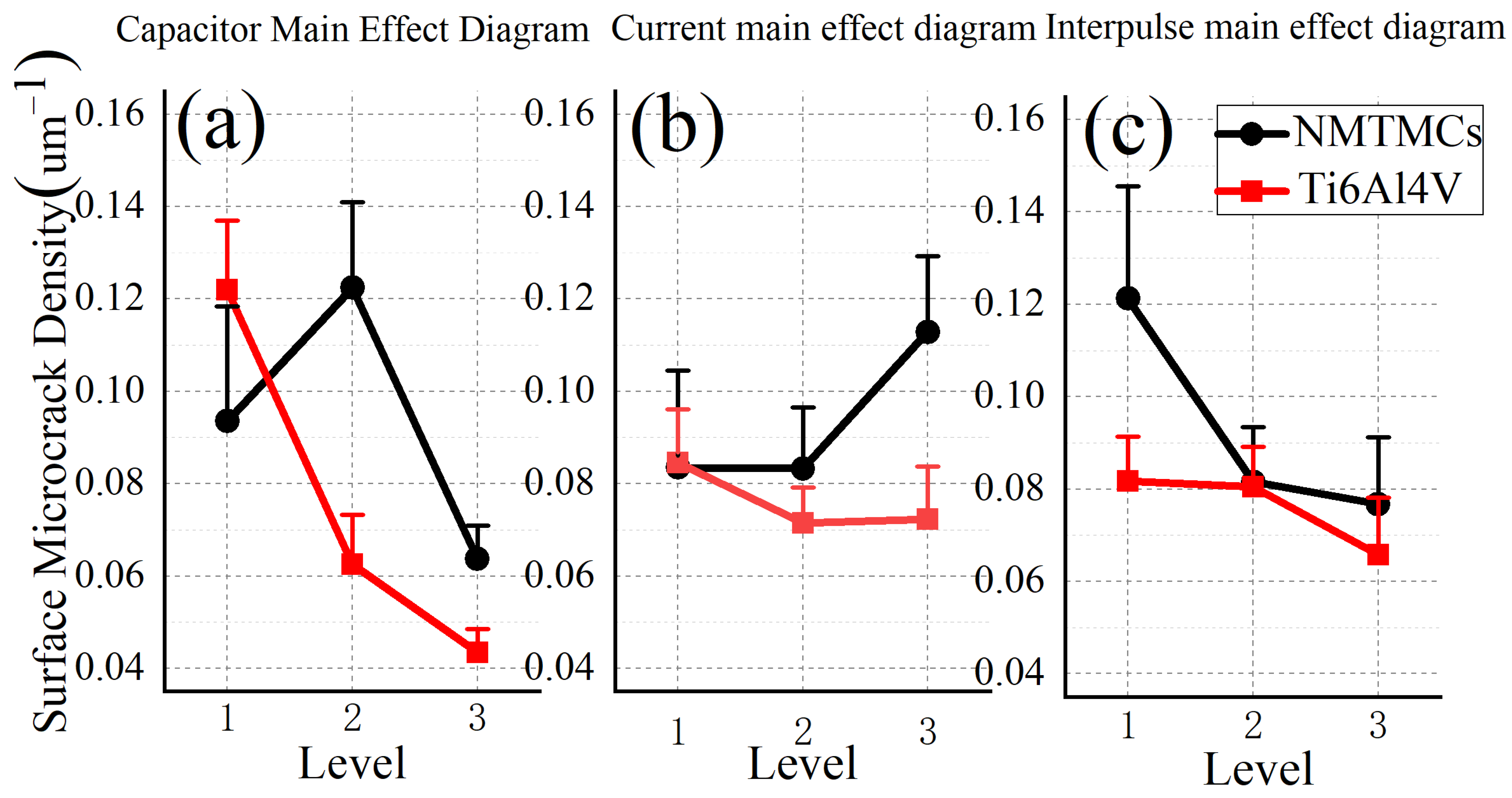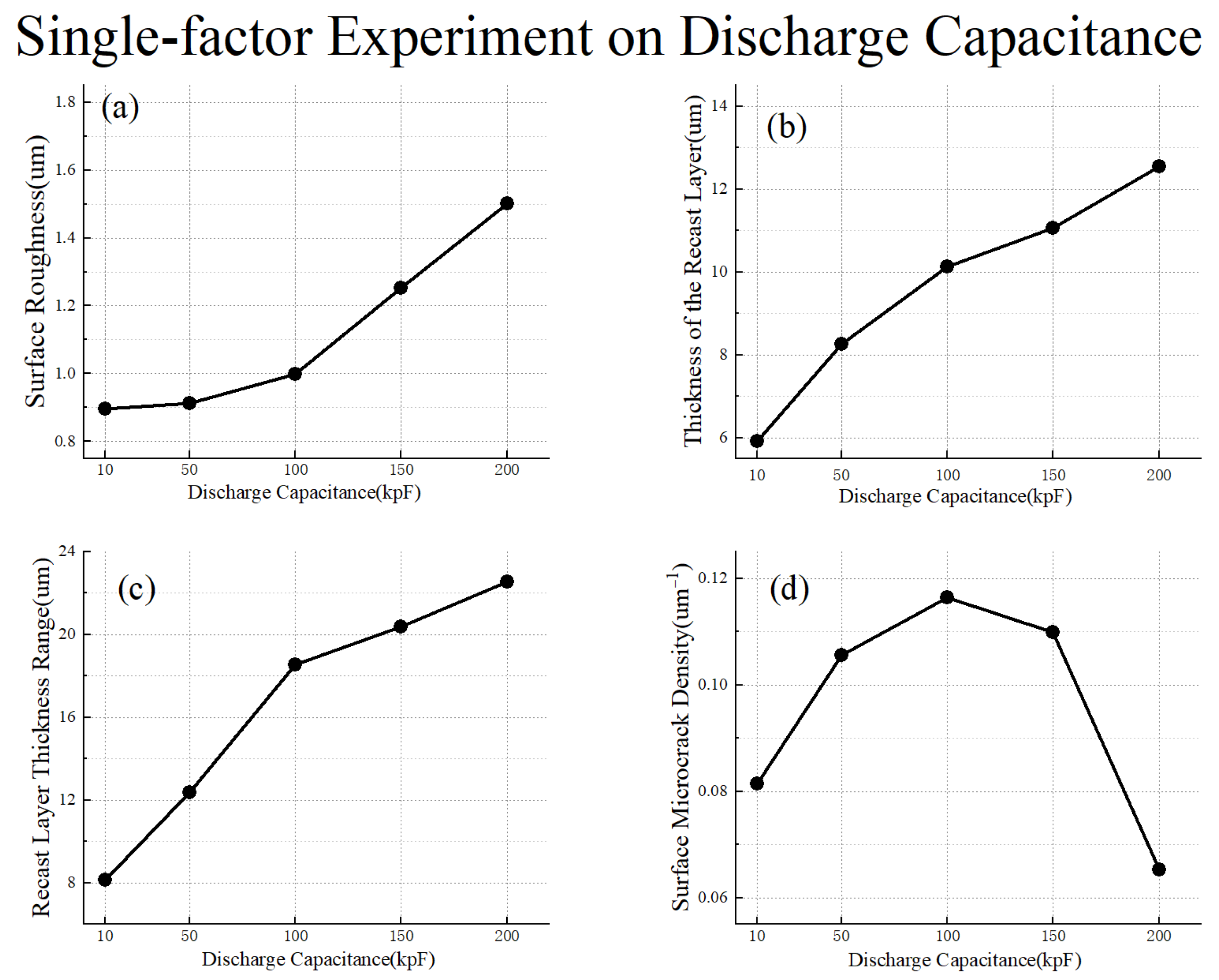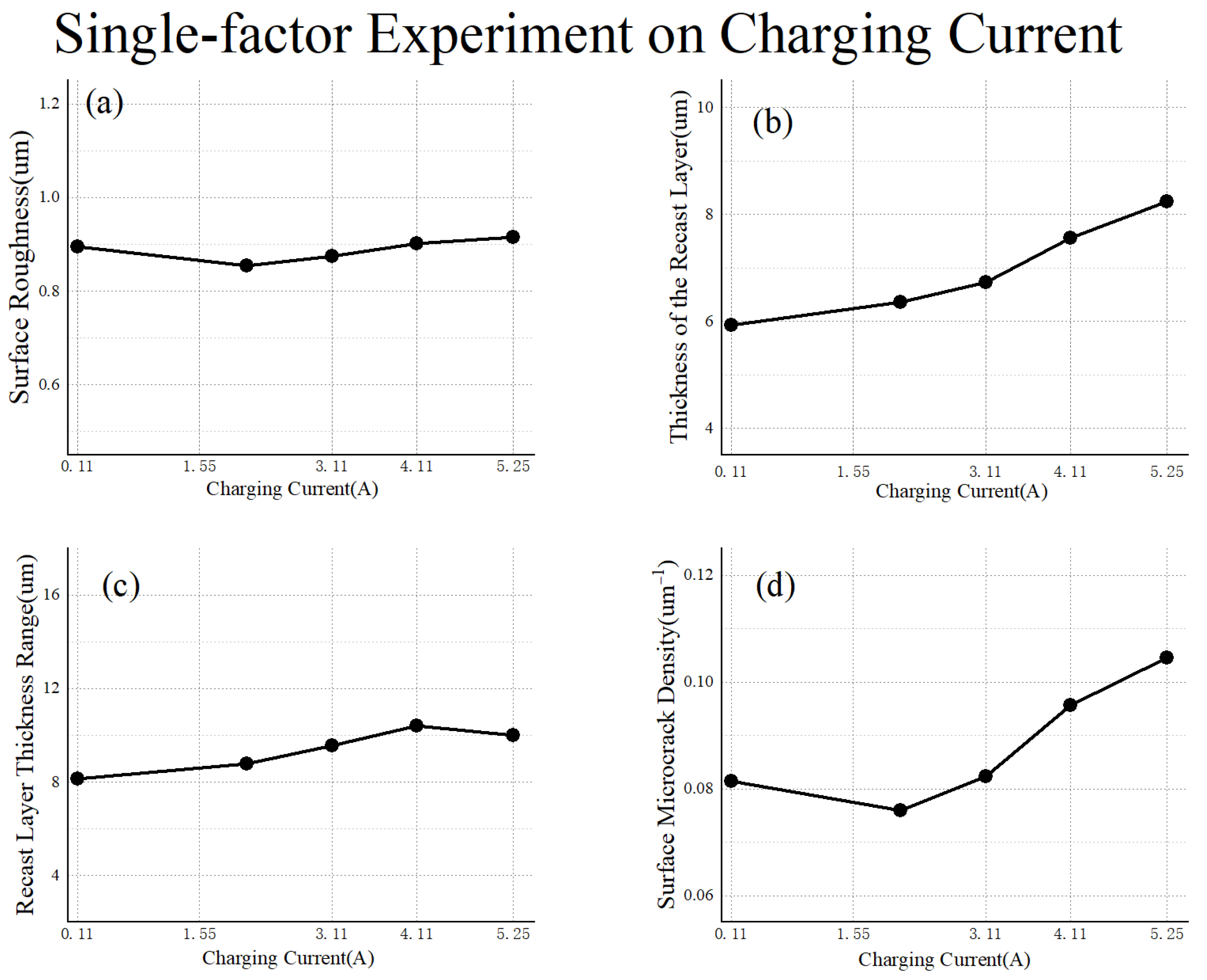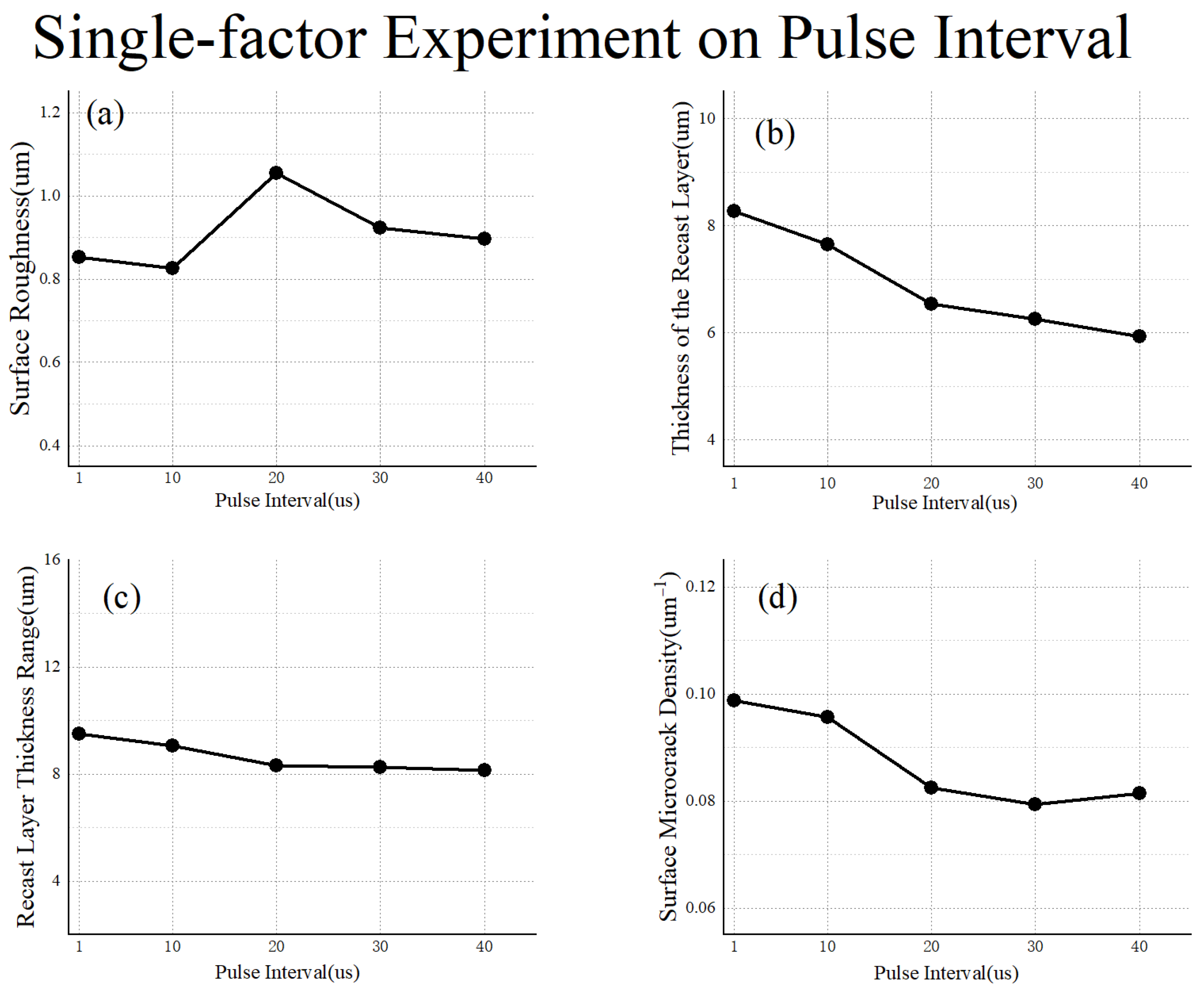3.1. Surface Roughness
The surface resulting from EDM is distinct from that achieved through traditional machining methods, consisting of numerous irregular and nondirectional pits that confer superior surface lubricity and wear resistance. Surface roughness is typically characterized by the arithmetic mean deviation of micro-irregularities (Ra) and the maximum height of these micro-irregularities (Rmax). In the context of EDM, various factors influence surface roughness, including the materials of the electrode and workpiece, single-pulse energy, working fluid, and pulse interval. Notably, single-pulse energy exerts the most profound influence on surface roughness. In this experiment, we employed the arithmetic mean deviation Ra as a metric to quantify the surface roughness of the processed workpiece, as detailed in Equation (3):
where
Ra represents the arithmetic mean deviation of micro-irregularities (in micron, μm);
l represents the sampling length (in micron, μm);
Z(
x) represents the function representing the difference between the micro-profile height of the workpiece and the average height. Roughness sampling length (lr) is 0.8 mm, roughness evaluation length (ln) is 4 mm, and cut off (
) is 1/10.
Utilizing the OLS3000 laser confocal microscope, we examined the surface morphology of the processed workpiece and fitted its roughness accordingly.
Figure 4 demonstrates the surface morphologies of NMTMCs and Ti6Al4V captured by laser confocal microscopy under varying processing energies. The surfaces exhibit a pattern of individual discharge craters, and as the discharge energy intensifies, the diameter of these craters correspondingly increases. Furthermore, under identical processing parameters, the degree of undulation in the discharge craters on the surface of NMTMC workpieces is noticeably lower than that observed on Ti6Al4V workpieces.
Figure 5 presents the main effect plots of surface roughness for NMTMCs and Ti6Al4V. As can be seen from
Figure 5a, as the discharge capacitance increases, the surface roughness of both materials also increases. This is because a larger discharge capacitance results in greater discharge energy and material removal rate, leading to larger discharge craters and consequently higher surface roughness. However, the growth rate of surface roughness for NMTMCs increases with the increase in discharge capacitance, while the growth rate for Ti6Al4V does not increase significantly. Additionally, under the same processing parameters, the surface roughness of NMTMCs is lower than that of Ti6Al4V. This can be attributed to the better high-temperature durability of NMTMCs compared to Ti6Al4V under the same conditions [
9], as NMTMCs have a higher melting point than Ti6Al4V. When processed with low energy, NMTMC materials are mainly removed through flushing after melting, resulting in smaller discharge craters and lower surface roughness. As the processing energy increases, material removal shifts to vaporization, leading to a significantly higher material removal rate and an increased growth rate of surface roughness. On the other hand, Ti6Al4V has a lower melting point, and its material removal is primarily through vaporization, even at low energy levels, resulting in less variation in the growth rate of surface roughness. Furthermore, due to the difference in melting points, the material removal rate of Ti6Al4V is higher than that of NMTMCs under the same processing parameters, explaining the generally higher surface roughness of Ti6Al4V workpieces.
Figure 5b indicates that the surface roughness of both materials does not change significantly with the increase in charging current. This is because the charging current does not directly affect the discharge energy. When the voltage across the discharge capacitance is constant, a higher charging current results in a shorter pulse width, which does not affect the surface roughness of the processed workpiece. From
Figure 5c, it can be observed that as the pulse interval increases, the surface roughness of NMTMC workpieces first increases and then decreases, while the change in surface roughness for Ti6Al4V workpieces is not significant. Since the melting point of NMTMCs is higher than that of Ti6Al4V, it is speculated that when the pulse interval is too short, the cooling time for NMTMC workpieces is insufficient, leading to partial liquid metal resolidified on the surface of the workpiece, resulting in a low material removal rate and low surface roughness. As the pulse interval increases, some of the liquid metal is removed by the working fluid, while some of it solidifies on the workpiece surface, resulting in a higher material removal rate in the center of the discharge craters and a lower rate at the edges, leading to increased surface roughness. With further increases in the pulse interval, the molten liquid metal is removed more efficiently, resulting in a surface roughness that is slightly higher than that obtained with a short pulse interval but lower than that with a medium pulse interval. On the other hand, Ti6Al4V has a lower melting point and can cool sufficiently even with short pulse intervals, making the effect of pulse interval changes on the surface roughness of Ti6Al4V workpieces less significant.
The mean response table for the surface roughness of NMTMCs is summarized in
Table 4. As evident from the table, the discharge capacitance exhibits the most profound influence on the surface roughness of the workpiece during processing, followed closely by the pulse interval. Conversely, the impact of charging current on surface roughness appears to be minimal and nearly negligible.
The mean response table for the surface roughness of Ti6Al4V is outlined in
Table 5. Notably, the table reveals that the discharge capacitance exerts the most profound influence on the surface roughness of the workpiece during processing. This is followed by the charging current and, subsequently, the pulse interval. A comparison between
Table 4 and
Table 5 underscores an interesting observation: under comparable conditions, the surface roughness values of Ti6Al4V workpieces tend to be slightly higher than those of NMTMCs. This finding aligns with the earlier analysis, further validating the trends observed.
In summary, the micro-EDM milling surface roughness of NMTMC workpieces can be optimized by adopting a capacitance range of 10–100 kpF and pulse intervals of either 1 μs or 40 μs.
3.2. Average Thickness and Uniformity of the Recast Layer
During the electric discharge machining process, when the electrode and workpiece are positioned close enough, a discharge breakdown occurs, resulting in instantaneous high temperatures. Subsequently, the molten metal material rapidly cools and solidifies under the cooling action of the working fluid, forming a recast layer. Unlike the metal matrix, the recast layer exhibits a dendritic quenched casting structure composed of martensite, a significant amount of fine-grained residual austenite, and certain carbides. However, due to the random and inhomogeneous nature of discharges, the thickness of the recast layer may vary even with identical processing parameters. To accurately represent the thickness of the recast layer, the average thickness is employed, as demonstrated in Equation (4):
where
h represents the average thickness of the recast layer (in micron, μm);
n represents the number of sampling times;
represents the maximum thickness of the recast layer in the nth photomicrograph (in micron, μm);
represents the minimum thickness of the recast layer in the nth photomicrograph (in micron, μm).
To accurately assess the uniformity of the recast layer, considering its inherent inhomogeneity, multiple samplings are conducted. The maximum and minimum thicknesses of the recast layer across all photomicrographs are determined, and the range between these values is calculated. This range serves as a metric to quantify the degree of uniformity in the recast layer, as outlined in Equation (5):
where
R represents the range of thicknesses of the recast layer obtained through sampling (in micron, μm);
represents the maximum thickness of the recast layer across all photomicrographs obtained through sampling (in micron, μm);
represents the minimum thickness of the recast layer across all photomicrographs obtained through sampling (in micron, μm).
EDM invariably gives rise to a recast layer, characterized by the presence of numerous defects like microcracks and micropores on its surface. In the case of composite materials, the swift cooling and solidification processes following the thermal removal of material alter the form of the reinforcement within the recast layer [
37]. Consequently, the surface properties of the recast layer differ significantly from those of the metal matrix. It is, therefore, of utmost importance to delve into the effects of various electrical machining parameters on both the thickness and the uniformity of the recast layer. By leveraging the distinct properties of the recast layer and the metal matrix, the workpiece surface can be etched, enabling clear observation of the recast layer under an electron microscope for varying processing energies, and the red arrows indicate the maximum and minimum widths of the recast layer, as exemplified in
Figure 6.
Based on the scale bar, the maximum and minimum thicknesses of the recast layer within each electron microscopy image’s field of view are determined, and the average of these two values is calculated as the average thickness of the recast layer.
Figure 7a presents the capacitance main effect plot comparing the average thickness of the recast layers for both materials. As the capacitance of the discharge capacitance increases, leading to a higher discharge energy, the material removal rate also increases. This increased removal results in a thicker recast layer due to the increased cooling and solidification processes. However, under identical processing conditions, the NMTMCs exhibit a thicker average recast layer compared to Ti6Al4V. This can be attributed to the adsorption of molten liquid metal by the reinforcement in NMTMCs. When processed with low energy, the NMTMC workpiece surface retains a higher concentration of residual reinforcement, enhancing its ability to adsorb the molten metal. Consequently, the average thickness of the recast layer for NMTMCs is 1.48 times thicker than that of Ti6Al4V under the same conditions. As the discharge energy is increased, the residual reinforcement on the NMTMC workpiece surface decreases, weakening its adsorption effect on the molten metal. Under high-energy processing conditions, the average thickness of the recast layer for NMTMCs decreases, but it remains 1.19 times thicker than that of Ti6Al4V under comparable conditions.
As depicted in
Figure 7b, the average thickness of the recast layer in NMTMCs exhibits a positive correlation with the charging current. As the charging current intensifies, the pulse width narrows, subsequently reducing the overall pulse duration. During micro-EDM milling, the electrode’s feed rate remains relatively sluggish. Consequently, under higher charging currents, the discharge distance diminishes during each discharge event, promoting the accumulation of the recast layer and subsequently increasing its average thickness. Conversely, the average thickness of the recast layer in Ti6Al4V remains less sensitive to charging current variations. Given that Ti6Al4V possesses a lower melting point than NMTMCs, its machining process is smoother, experiencing fewer instances of short-circuiting and retractions. This characteristic minimizes the accumulation of the recast layer during machining, thereby mitigating the impact of charging current on its thickness.
Figure 7c reveals that the pulse interval plays a pivotal role in determining the duration between pulses. An increase in the pulse interval elongates the overall pulse duration, making it less probable for the recast layer in NMTMCs to accumulate, thus resulting in a thinner average thickness. Similarly, the average thickness of the recast layer in Ti6Al4V remains relatively unaffected by variations in the pulse interval.
The mean response table summarized in
Table 6 illustrates the varying impacts on the average thickness of the recast layer in NMTMCs. Among the factors, the discharge capacitance exerts the most prominent influence, closely followed by the charging current, and lastly, the pulse interval.
The mean response table outlined in
Table 7 reveals the varying degrees of influence on the average thickness of the recast layer in Ti6Al4V. Notably, the discharge capacitance emerges as the most significant factor, followed closely by the pulse interval, and ultimately, the charging current.
In summary, the micro-EDM milling of the NMTMC workpiece can be optimized by employing a 10 kpF capacitance, a charging current of 0.11 A, and a pulse interval of 40 μs, thereby minimizing the thickness of the recast layer.
The uniformity of the recast layer serves as a critical indicator of its overall properties. The inherent randomness of EDM processes often results in non-uniform thickness within the recast layer. Consequently, we employ the recast layer’s thickness range as a metric to assess its uniformity.
Figure 8 presents the main effect diagram for the recast layer’s thickness range of both materials. As evident in
Figure 8a, an increase in discharge capacitance leads to a widening range of thickness variations in both NMTMCs and Ti6Al4V. This is attributed to the higher discharge energy associated with a larger discharge capacitance, causing random discharges from the tool electrode and, in turn, enhancing thickness variations. However, under conditions of low machining energy, NMTMCs exhibit a greater range of thickness variations compared to Ti6Al4V. This is due to the uneven exposure of reinforcement on the NMTMC surface, which attracts liquid metal and contributes to the increased variations. As the machining energy rises to a certain threshold, most reinforcement on the workpiece surface is removed, resulting in comparable ranges of thickness variations in both materials.
Figure 8b,c illustrate that in NMTMCs, the range of thickness variations initially rises with an increase in charging current but then plateaus. Similarly, as the pulse interval widens, the range of thickness variations decreases initially and then stabilizes. Since charging current and pulse width are inversely related, it can be deduced that the overall pulse duration significantly impacts the range of thickness variations in the workpiece’s recast layer. Limited tool electrode feed rates result in closer discharge distances on the workpiece during shorter pulse durations, leading to repeated discharges and greater thickness variations. Conversely, as the pulse duration extends, discharge distances on the workpiece increase, eliminating repeated discharges and stabilizing the range of thickness variations at a lower level. Conversely, Ti6Al4V, with its lower melting point, is less susceptible to the accumulation of the recast layer. Consequently, the range of thickness variations in its recast layer is less influenced by the overall pulse duration, rendering the effects of charging current and pulse interval insignificant.
The mean response table presented in
Table 8 illustrates the variance in the thickness of the recast layer for NMTMCs. Notably, the discharge capacitance exhibits the most prominent influence on this variance, whereas the charging current and pulse interval exert comparatively lesser effects.
The mean response table for the variance in recast layer thickness of Ti6Al4V is detailed in
Table 9. Notably, the discharge capacitance stands out as the most influential factor, whereas the charging current and pulse interval exert relatively minor impacts.
In summary, the inhomogeneity of the recast layer during the micro-EDM milling process of the NMTMC workpiece can be effectively minimized by utilizing a 10 kpF capacitance, a charging current of 0.11 A, and a pulse interval of 40 μs.
3.3. Surface Microcrack Density
When the surface of the workpiece is exposed to electric spark discharge, it experiences instantaneous high-temperature melting and rapid cooling and solidification under the influence of the working fluid. This process generates residual tensile stress, leading to the formation of microcracks on the surface, which in turn compromises the surface properties of the workpiece. To quantify the extent of these microcracks, we utilized the surface microcrack density as a metric, as outlined in Equation (6):
where
ρ represents the surface microcrack density (in per micron, μm
−1);
L represents the total length of cracks in the sampled electron micrograph (in micron, μm);
S represents the area of the sampled electron micrograph (in square micron, μm
2).
The microcracks present on the machined surface of the workpiece, as depicted in
Figure 9, have a profound effect on its surface quality, leading to a decrease in fatigue strength [
38]. Consequently, studying the impact of machining electrical parameters on the density of these surface microcracks holds significant importance.
As depicted in
Figure 10a, the surface microcrack density of NMTMCs processed via EDM initially surges and subsequently tapers off with an increase in discharge capacitance. This trend can be attributed to the transition in material removal mechanisms. During medium- to low-energy processing, the primary mechanism of material removal involves melting and flushing with liquid. Initially, at lower energy levels, a thinner recast layer is formed. However, as the discharge capacitance gradually increases, the resolidified liquid metal encapsulates the reinforcing phase, leading to a marked decline in the material’s thermal conductivity. Consequently, this gives rise to substantial residual tensile stress and a corresponding elevation in the density of surface microcracks. However, as the discharge capacitance reaches a critical threshold, material removal shifts towards vaporization, causing a decrease in the reinforcement content within the recast layer [
31], which leads to the formation of a thicker and more uniform recast layer. This shift results in more uniform heat conduction, decreased residual stress, and, ultimately, a reduction in surface microcrack density. On the other hand, the surface microcrack density of Ti6Al4V exhibits a decreasing trend with an increase in discharge capacitance. As illustrated in
Figure 7a, a larger discharge capacitance correlates with a thicker average recast layer for Ti6Al4V, promoting more uniform heat conduction. This, in turn, results in smaller residual tensile stress and, consequently, a lower surface microcrack density.
Figure 10b,c reveal that the surface microcrack density of NMTMCs remains stable initially and then rises with an increase in charging current. Conversely, it decreases and subsequently plateaus with an increase in pulse interval. This behavior can be explained by the inhomogeneous distribution of the reinforcement within the recast layer, leading to poor heat conduction. This inhomogeneity also accounts for the higher surface microcrack density observed in NMTMCs compared to Ti6Al4V. The unevenness of the NMTMC recast layer renders its surface microcrack density highly sensitive to cooling time. High charging currents result in narrow pulse widths, and a combination of narrow pulse widths and short pulse intervals can lead to inadequate cooling time between discharges. This insufficient cooling time contributes to a higher surface microcrack density in NMTMCs. However, once the pulse time exceeds a certain threshold, the surface microcrack density remains unaffected. In contrast, the surface microcrack density of Ti6Al4V is less influenced by charging current and pulse interval. The absence of reinforcement in Ti6Al4V results in a more uniform recast layer and superior heat conduction properties, minimizing the sensitivity to cooling time variations.
The mean response table for the surface microcrack density of NMTMCs is outlined in
Table 10. According to the table, the discharge capacitance exerts the most prominent influence on the surface microcrack density of the workpiece, followed closely by the pulse interval. Conversely, the charging current has the least notable impact on the surface microcrack density of the workpiece.
The mean response table for the surface microcrack density of Ti6Al4V is clearly delineated in
Table 11. According to the tabulated data, the discharge capacitance stands out as the most notable factor influencing the surface microcrack density of the workpiece. In contrast, both the charging current and pulse interval exert comparatively less significant impacts on the surface microcrack density of the workpiece.
In summary, the micro-EDM milling process of the NMTMC workpiece can be optimized to minimize surface microcrack defects by employing either a 10 kpF or 200 kpF capacitance, a charging current of 0.11 A, and a pulse interval of either 20 μs or 40 μs.
3.4. Single-Factor Verification Experiment
For NMTMC workpieces, the optimal electrical parameters for micro-EDM milling processing include a 10 kpF capacitance, a charging current of 0.11 A, and a pulse interval of 40 μs. On this foundation, three sets of single-factor verification experiments were meticulously designed to ascertain the most suitable process parameters for NMTMCs. During each experiment, only one factor was varied while the remaining two were maintained at their optimal settings, as shown in
Table 12,
Table 13 and
Table 14.
As shown in
Figure 11, with the increase in discharge capacitance, the surface roughness, the thickness of the recast layer, and the recast layer thickness range all increase accordingly. Additionally, the growth rate of surface roughness also increases as the discharge capacitance increases, which is consistent with the previously analyzed conclusion. Simultaneously, as the discharge capacitance increases, the density of surface microcracks exhibits a trend of initial increase followed by a decrease. Notably, the density remains consistently high within the range of 50 kpF to 150 kpF for the discharge capacitance. Based on these observations, we can deduce that when the discharge capacitance is minimal, the recast layer assumes a thinner profile, resulting in average thermal conductivity. However, as the discharge capacitance increases, a considerable amount of reinforced phase is incorporated within the recast layer, leading to a precipitous decline in thermal conductivity and a corresponding surge in the density of surface microcracks. Conversely, once the discharge capacitance attains a critical threshold, the reinforced phase within the recast layer is effectively eliminated, yielding a thicker and more uniform recast layer that exhibits superior thermal conductivity and a reduced density of surface microcracks.
As shown in
Figure 12, under conditions of low energy and large pulse intervals, the surface roughness and the recast layer thickness range exhibit minimal changes with the increase in charging capacitance. With the growth of charging capacitance, the thickness of the recast layer and the density of surface microcracks initially remain relatively stable, followed by a slight increase. This can be explained by the limitations imposed by the conditions of low energy and large pulse intervals.
Similarly, given the low energy and small charging current, the pulse interval exerts a minor influence on the surface roughness and the recast layer thickness range. As the pulse interval widens, the thickness of the recast layer and the density of surface microcracks decrease, aligning with prior observations. However, the magnitude of these variations remains relatively insignificant, as depicted in
Figure 13.
In conclusion, the optimal process parameters for micro-EDM milling of NMTMCs comprise a discharge capacitance of 10 kpF, a charging current of 0.11 A, and a pulse interval of 40 μs, which attain a processing effect that features a roughness of Ra 0.9 μm, an average recast layer thickness of 6 μm with a range of 8 μm, and a surface microcrack density of 0.08 μm−1.
